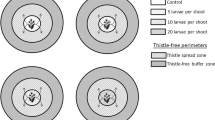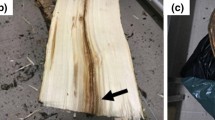Abstract
The leaf-feeding beetle Zygogrammabicolorata Pallister was introduced from Mexico intoAustralia in 1980 as a biocontrol agent for the weedParthenium hysterophorus L. (Asteraceae). Z. bicolorata became abundant in 1990, and since 1992there has been regular outbreaks resulting in thedefoliation of the weed in central Queensland. In thisstudy we evaluated the impact of defoliation by Z. bicolorata on P. hysterophorus from 1996 to1998. Z. bicolorata caused 91–100% defoliationresulting in reductions in weed density by 32–93%,plant height by 18–65%, plant biomass by 55–89%,flower production by 75–100%, soil seed-bank by13–86% and seedling emergence in the following seasonby 73–90%. At sites with continued outbreaks ofZ. bicolorata, it is expected that the existing soilseed-bank will be minimised, resulting in reduceddensity of parthenium in 6 to 7 years.
Similar content being viewed by others
References
Adamson, D.C., 1996. Introducing dynamic considerations when economically evaluating weeds. Masters Thesis, University of Queensland, Brisbane.
Adkins, S.W., S.C. Navie, G.C. Graham and R.E. McFadyen, 1997. Parthenium weed in Australia: research underway at the co-operative research centre for tropical pest management. In: M. Mahadeveppa and V.C. Patil (eds), First International Conference on Parthenium Management, University of Agricultural Sciences, Dharwad, India. pp. 13–18.
Annadurai, R.S., 1989. Reproductive potential in terms of quantitative food utilisation of Zygogramma bicolorata (Coleoptera: Chrysomelidae) on Parthenium hysterophorus (Asteraceae). In: E.S. Delfosse (ed), Seventh International Symposium on the Biological Control of Weeds, Rome, Italy. pp. 385–394.
Blossey, B., 1992. Impact of Galerucella pusilla and G.calmariensis (Coleoptera: Chrysomelidae) on field populations of purple loosestrife (Lythrum salicaria). In: E.S. Delfosse and R.R. Scott (eds), Eight International Symposium on the Biological Control of Weeds, Lincoln University, Canterbury, New Zealand. pp. 27–31.
Cheney, M., 1998. Determination of the prevalence of sensitivity to Parthenium in areas of Queensland affected by the weed. Master of Public Health Thesis, Queensland University of Technology, Brisbane, Australia. p. 118.
Chippendale, J.F. and F.D. Panetta, 1994. The cost of parthenium weed to the Queensland cattle industry. Plant Prot.Quart. 9: 73–76.
Dhileepan, K. and R.E McFadyen, 1997. Biological control of parthenium in Australia: progress and prospects. In: M. Mahadeveppa and V.C. Patil (eds), First International Conference on Parthenium Management, University of Agricultural Sciences, Dharwad, India. pp. 40–44.
Dhileepan, K., B. Madigan, M. Vitelli, R.E. McFadyen, K. Webster and M. Trevino, 1996. A new initiative in the biological control of parthenium. In: R.C.H. Shepherd (ed), Proceeding of the Eleventh Australian Weeds Conference, Weed Science Society of Victoria, Australia. pp. 309–312.
Dhileepan, K., S.D. Setter and R.E. McFadyen, 2000. Response of the weed Parthenium hysterophorus (Asteraceae) to the defoliation by the introduced biocontrol agent Zygogramma bicolorata (Coleoptera: Chrysomelidae). Biol.Control 11 (in press).
Haseler, W.H., 1976. Parthenium hysterophorus L. in Australia. PANS 22: 515–80.
Jayanth, K.P., 1987. Introduction and establishment of Zygogramma bicolorata on Parthenium hysterophorus in Bangalore, India. Curr.Sci. 56: 310–311.
Jayanth, K.P. and G. Bali, 1993a. Biological studies on Zygogramma bicolorata Pallister (Coleoptera: Chrysomelidae), a biocontrol agent of Parthenium hysterophorus L. (Asteraceae). J.Biol.Control 7: 93–98.
Jayanth, K.P. and G. Bali, 1993b. Diapause behaviour of Zygogramma bicolorata (Coleoptera: Chrysomelidae), a biocontrol agent of Parthenium hysterophorus in Bangalore, India. Bull.Entomol.Res. 83: 383–388.
Jayanth, K.P. and G. Bali, 1993c. Temperature tolerance of Zygogramma bicolorata (Coleoptera: Chrysomelidae) introduced for biological control of Parthenium hysterophorus (Asteraceae) in India. J.Entomol.Res. 17: 27–34.
Jayanth, K.P. and G. Bali, 1994a. Biological control of parthenium by the beetle Zygogramma bicolorata in India. FAO Plant Prot.Bull. 42: 207–213.
Jayanth, K.P., and G. Bali, 1994b. Life table of the parthenium beetle Zygogramma bicolorata Pallister (Coleoptera: Chrysomelidae) in Bangalore, India. Insect Sci.App. 15: 19–23.
Jayanth, K.P. and P.N.G. Visalakshy, 1994. Dispersal of the parthenium beetle Zygogramma bicolorata (Chrysomelidae) in India. Biocontrol Sci.Tech. 4: 363–365.
Jayanth, K.P. and P.N.G. Visalakshy, 1996. Succession of vegetation after suppression of parthenium weed by Zygogramma bicolorata in Bangalore, India. Biol.Agri.Hort. 12: 303–309.
Jayanth, K.P., S. Mohandas, R. Asokan and P.N.G. Visalakshy, 1993. Parthenium pollen induced feeding by Zygogramma bicolorata (Coleoptera: Chrysomelidae) on sunflower. Bull.Entomol.Res. 83: 595–598.
Jayanth K.P., P.N.G. Visalakshy, S.K. Ghosh and M. Chaudhary, 1997. Feasibility of biological control of Parthenium hysterophorus by Zygogramma bicolorata in the light of the controversy due to its feeding on sunflower. In: M. Mahadeveppa and V.C. Patil (eds), First International Conference on Parthenium Management, University of Agricultural Sciences, Dharwad, India. pp. 45–51.
Kololgi, P.D., S.D. Kololgi and N.P. Kololgi. 1997. Dermatologic hazards of parthenium in human beings. In: M. Mahadeveppa and V.C. Patil (eds), First International Conference on Parthenium Management, University of Agricultural Sciences, Dharwad, India. pp. 18–19.
Kovalev, O.V and L.N. Madvedev, 1983. Theoretical principles for the introduction of Ambrosia leaf beetles of the genus Zygogramma Chevr. (Coleoptera: Chrysomelidae) in the USSR for the biological control of Ambrosia Entom.Obozrenie. 62: 1–19.
Lonsdale, W.M., G. Farrell and C.G. Wilson, 1995. Biological control of a tropical weed: a population model and experiment for Sida acuta. J.Appl.Ecol. 32: 319–99.
McFadyen, R.E., 1992. Biological control against Parthenium weed in Australia. Crop Prot. 11: 400–407.
McFadyen, R.E., 1993. Biological control of weeds in Queensland: recent developments. In: L.R. Tanner (ed), Seventh Biennial Noxious Plants Conference, New South Wales Department of Agriculture, Sydney, Australia. pp. 67–71.
McFadyen, R.E. 1995. Parthenium weed and human health in Queensland. Aust.Family Physician 24: 1455–1459.
McFadyen, R.E. and McClay, A.R, 1981. Two new insects for the biological control of parthenium weed in Queensland. In: B.J. Wilson and J.D. Swarbrick (eds), Sixth Australian Weeds Conference, Weed Science Society of Queensland, Australia. pp. 145–149.
Navie, S.C., F.D. Panetta, R.E. McFadyen and S.W. Adkins, 1998. Behaviour of buried and surface-lying seeds of parthenium weed (Parthenium hysterophorus L.). Weed Res. 38: 338–341.
Navie, S.C., R.E. McFadyen, F.D. Panetta and S.W. Adkins, 1996. The biology of Australian weeds 27. Parthenium hysterophorus L. Plant Prot. 11: 76–88.
Prins, A.H. and H.J. Verkaar, 1992. Defoliation: do physiological and morphological responses lead to (over) compensation? In: P.G. Ayres (ed), Pests and pathogens.Plant response to foliar attack, Environmental Plant Biology Series, Bios Scientific Publishers, Oxford. pp. 13–31.
Reznik, S.YA., S.A. Belokobylskiy and A.L. Lobanov, 1994. Weed and herbivorous insect population densities at the broad spatial scale: Ambrosia artemisiifolia L. and Zygogramma suturalis F. (Coleoptera: Chrysomelidae). J.Appl.Ent. 118: 1–9.
Visalakshy, P.N.G. and K.P. Jayanth, 1999. Histolysis and development of flight muscles in Zygogramma bicolorata, an effective natural enemy of Parthenium hysterophorus. Entomon. 24: 2125.
Withers, T.M. 1998. Influence of plant species on host acceptance behaviour of the biocontrol agent Zygogramma bicolorata (Coleoptera: Chrysomelidae). Biol.Control 13: 55–62.
Author information
Authors and Affiliations
Corresponding author
Rights and permissions
About this article
Cite this article
Dhileepan, K., Setter, S. & McFadyen, R. Impact of defoliation by the biocontrol agentZygogramma bicolorataon the weed Partheniumhysterophorus in Australia. BioControl 45, 501–512 (2000). https://doi.org/10.1023/A:1026528304473
Issue Date:
DOI: https://doi.org/10.1023/A:1026528304473




